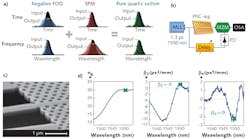Solitons: Shorter pulses increase energy of new, Gaussian, pure-quartic solitons
In early 2014, a research team led by the Centre for Ultrahigh bandwidth Devices for Optical Systems (CUDOS) at the University of Sydney (Sydney, NSW, Australia) succeeded in compressing 3.7 ps soliton pulses (single waves that maintain their shape, even after traveling long distances) with 10 pJ of energy to a 1.6 ps duration using a dispersion-engineered, slow-light photonic-crystal waveguide—a feat that continues to drive researchers towards achieving highly efficient, soliton-based on-chip optical communication.
But just when researchers thought that soliton behavior was well understood, the CUDOS researchers, with help from the University of Toronto (Toronto, ON, Canada) and the University of York (York, England), discovered a new class of solitons, dubbed pure-quartic, that not only has a different shape than conventional solitons, but possesses more energy at shorter pulsewidths.1 In addition to applications in high-bandwidth communications and frequency combs, the new solitons could find significant success in ultrafast-laser applications.
Why pure-quartic?
Temporal solitons can be created in a variety of optical media through the interaction of group-velocity dispersion (GVD) and self-phase modulation (SPM) because of the nonlinear Kerr effect. Often, temporal solitons are perturbed by the additional presence of third-order dispersion (TOD) and fourth-order dispersion (FOD). But a new class of soliton has been dubbed pure-quartic as it is created purely from the interaction of negative FOD (quartic dispersion) and SPM, even when GVD is normal or absent.
Although the researchers created these pure-quartic solitons in photonic-crystal waveguides, they could also occur in other physical platforms such as optical fibers and free-space ultrafast laser cavities. In fact, it appears that pulse shaping in ultrafast laser cavities (for pulses below 10 fs) is influenced primarily by the balance of SPM and FOD.
To create the solitons, a frequency-resolved electrical gating setup is used, whereby 1550 nm, 1.3-ps-pulse-duration light from a mode-locked laser (MLL) is input to an engineered photonic-crystal waveguide (PhC-wg) cavity and a small copy of that pulse is detected by an ultrafast photodiode (PD) after passing through a tunable delay (see figure). The output of the PhC-wg, combined with the output of the PD via a Mach-Zehnder modulator (MZM), is analyzed with an optical-spectrum analyzer (OSA) that records the spectrum as a function of delay.
Measurements show that unlike conventional solitons, pure-quartic solitons are significantly different in that they possess much higher energies for ultrashort pulses and have an approximate Gaussian shape compared to typical hyperbolic secant beam profiles.
For an engineered, 396-μm-long slow-light silicon waveguide, interferometric measurements of the 1550-nm-central-wavelength soliton pulse confirm that the PhC-wg cavity has a group index of 30, a normal dispersion or GVD of +1 ps2/mm, a TOD of +0.02 ps3/mm, and an FOD of −2.2 ps4/mm, with the FOD being negative in a 6 nm wavelength range about the center wavelength.
"Pure-quartic solitons present strikingly different physical properties compared to conventional solitons, some of which present a great potential for certain technological applications," says University of Sydney postdoctoral researcher Andrea Blanco-Redondo. "For example, their particular dispersion relation has the potential to impose much less stringent limits on the pulse duration in laser cavities, which in combination with their advantageous energy scaling could make pure-quartic soliton lasers rival the current standard for high-energy fiber lasers without the need of a post-compressor stage."
REFERENCE
1. A. Blanco-Redondo et al., Nature Commun., 7, 10427 (Jan. 29, 2016).

Gail Overton | Senior Editor (2004-2020)
Gail has more than 30 years of engineering, marketing, product management, and editorial experience in the photonics and optical communications industry. Before joining the staff at Laser Focus World in 2004, she held many product management and product marketing roles in the fiber-optics industry, most notably at Hughes (El Segundo, CA), GTE Labs (Waltham, MA), Corning (Corning, NY), Photon Kinetics (Beaverton, OR), and Newport Corporation (Irvine, CA). During her marketing career, Gail published articles in WDM Solutions and Sensors magazine and traveled internationally to conduct product and sales training. Gail received her BS degree in physics, with an emphasis in optics, from San Diego State University in San Diego, CA in May 1986.
